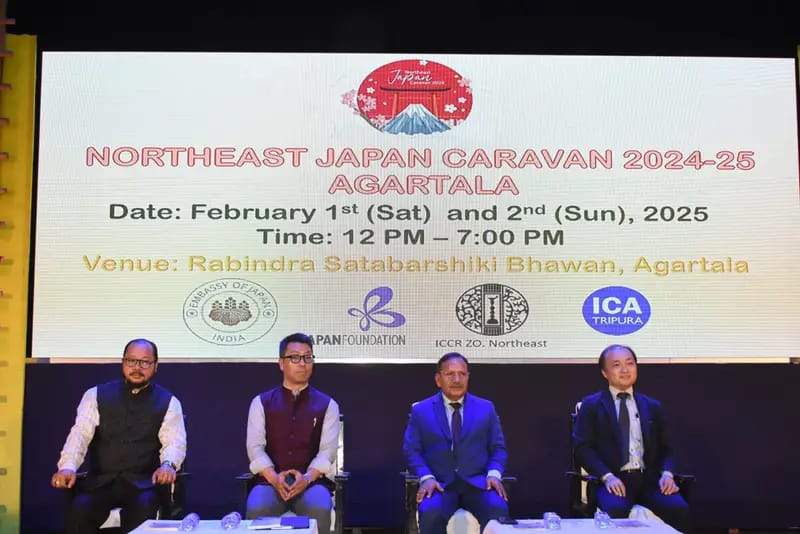In the past decade, North-East India has received significant importance and has been at the focal point of India’s Act East Policy. New Delhi has shown renewed vigour and urgency in promoting development in NER, and the area has been a recipient of several big-ticket infrastructural projects that have been driven at a rapid rate. The most recent example of it can be the expansion of the railway network to Mizoram, as direct train connectivity between Kolkata and Sairang was established very recently. As the push to transform North East India into India’s strategic gateway for South-East Asia gains momentum, Japan has emerged as the region’s most reliable and strategic partner. From infrastructure to Agri-tech, logistics and cultural aspects, Japanese companies and industry members have proactively aided the region's holistic development.
ALSO READ| Raksha Bandhan 2025 celebrations sweep India, but the Seven Sisters remain on the sidelines
Infrastructure Development: Bridging the Gaps
With a strong push being given towards creating North East India into a major logistics hub, there has been an increased emphasis on large-scale infrastructure development, especially with highways. JICA(Japan International Co-operation Agency) has been a pioneer in this regard. The aid agency has provided loan grants worth INR 1,946 crores for the marquee project of constructing the Dhubri-Fulbari bridge, India’s longest river bridge over the Brahmaputra River. The bridge would significantly ease travel time between Assam and Meghalaya and help boost trade, movement, and connectivity in the region. JICA has also played a key role in the improvement and widening of the Khowai–Teliamura–Harina road section in Tripura, a project that is still ongoing. The ODA loan component given by JICA for this project has been slightly above 1500 crore.
Technological Aspect: Semiconductor Industry in Assam
Jagiroad in Assam is the destination of North-East India’s first-ever Semiconductor plant in the region, and this semiconductor revolution is being driven by TATA. The investment by the TATA group has created a significant buzz in the Japanese industrial segments. During the Fifth Indo-Japan Intellectual Conclave 2025 held in February this year, Japanese Ambassador to India, H.E Mr Ono Keiichi visited the semi-conductor plant site at Jagiroad with the Japanese delegation and various other industry members. The visit by the ambassador created a positive impact for the project and also accelerated the conversations surrounding the sub-ecosystem. The Japan Bank of International Cooperation (JBIC) together with Japan Chamber of Commerce and Industry in India (JCCII) and Japan External Trade Organization (JETRO), held the fifth meeting of the JCCII Semiconductor Committee on March 3, 2025. The conference marked a significant milestone regarding facilitating the conversations around the semi-conductor industry with NER emerging as an important potential area of co-operation.
ALSO READ| The Women who no longer pluck tea
Promoting Agri-Tech collaboration and Sustainable Development
Japanese industries have actively cooperated with North-East Indian states, especially Meghalaya, which has taken the collaborations on sustainable development to the next level. The MegLIFE (Meghalaya Livelihood and Forest Ecosystem Management Project)
project initiated by the government of Meghalaya is being funded by JICA as well. The funding given for each of the community centers is INR 13 lakh from JICA. The projects aims to promote community based forest management and improvement of livelihoods across 500 villages in 12 districts of the state. The initiative seeks to involve Integrated Village Cooperative Societies (IVCS) and Self-Help Groups (SHGs) as crucial partners in the implementation of activities like nurseries, plantations, minor irrigation, and water storage infrastructure.
Besides, Meghalaya has also actively adopted the sustainable afforestation techniques used by Japanese botanist Akira Miyawaki in a project that has been initiated by the state soil and water conservation department. The state has also seen bilateral collaboration and support from the Japanese industrial company, YATS corporation for the boost in production of the organic Shiitake mushrooms in the region. In Assam, JBIC has also signed a partnership worth INR 3200 crores with the state run Power Finance Corporation for sponsoring bamboo based bio-ethanol and chemical projects in the state. The initiative is an extended part of India’s push towards NET ZERO and GREEN ENERGY alternatives with North-East India being pushed a focal point in the developments.
People-to-People Connect and the road ahead
Initiatives such as the North-East Japan Caravan in Agartala, Tripura, during 2025, along with the Cherry Blossom Festival in Shillong, Meghalaya, have paved the way for greater cross-cultural ties between NER and Japan. The new generation of youngsters in the region has been able to connect to the Japanese traditions and cultures like Anime, Manga and cosplay, and this has enhanced the people-to-people ties. At the same time, the sustained collaboration efforts by Japan through its various agencies like JICA, JETRO, JBIC and other companies have created new possibilities of synergy between technological co-operation and developmental expertise in the region. The intersection of culture, innovation and infrastructure has given a major boost to the North-East Japan Partnership. It has the capacity to act in the future as a cornerstone of Japan’s outreach in the Bay of Bengal region as well as India’s Act East Policy, thereby enhancing resilience, interconnectivity and prosperity in the region.
{Soumarya Dutta is a Research and Program Associate at North-East India’s premier Think Tank, Asian Confluence, Shillong. His work focuses on regional connectivity and development cooperation in North-East and Southeast Asia. With an academic background in Conflict Management and Development, he explores the intersections of ecology, economy, and geopolitics in India’s Northeast and the Bay of Bengal region.}










